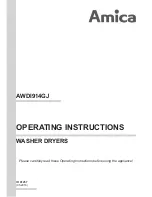
2. Add the rinse aid in the container. The
maximum level for filling is indicated by
"max".
The dispenser holds about 110 ml of rinse
aid, which is sufficient for between 16 and
40 washing cycles, depending upon the
dosage setting.
3. Ensure that the lid is closed after every
refill.
Clean up any rinse aid spilt during filling
with an absorbent cloth to avoid excess
foaming during the next wash.
According to the finish and drying results ob-
tained, adjust the dose of rinse aid by means
of the 6 position selector (position 1 minimum
dosage, position 6 maximum dosage).
The dose is factory set in position 4.
Increase the dose if there are drops of water
or lime spots on the dishes after washing.
Reduce it if there are sticky whitish streaks
on the dishes or a bluish film on glassware or
knife blades.
Daily use
• Check if it’s necessary to refill with dish-
washer salt or rinse aid.
• Load cutlery and dishes into the dishwash-
er.
• Fill with dishwasher detergent.
• Select a wash programme suitable for the
cutlery and dishes.
• Start the wash programme.
Helpful hints and tips
Sponges, household cloths and any object
that can absorb water may not be washed in
the dishwasher.
• Before loading the dishes, you should:
– Remove all left over food and debris.
– Soften remnants of burnt food in pans
• When loading the dishes and cutlery,
please note:
– Dishes and cutlery must not impede the
rotation of the spray arms.
– Load hollow items such as cups,
glasses, pans, etc. with the opening
downwards so that water cannot collect
in the container or a deep base.
– Dishes and items of cutlery must not lie
inside one another, or cover each other.
– To avoid damage to glasses, they must
not touch.
– Lay small objects in the cutlery basket.
electrolux
9
Summary of Contents for Athur Martin ASF66811
Page 1: ...user manual Dishwasher ASF66811 ...
Page 25: ...electrolux 25 ...
Page 26: ...26 electrolux ...
Page 27: ...electrolux 27 ...










































